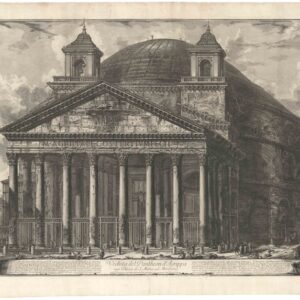Giovanni Battista Piranesi was one of the most influential Italian artists and printmakers of the 18th century, known for his architectural fantasies, archaeological reconstructions, and monumental engravings of ancient and modern Rome. Born in Mogliano Veneto, near Venice, he trained in architecture and engraving before moving to Rome in the early 1740s.
In Rome, Piranesi developed a passionate interest in the ruins of antiquity, which he believed demonstrated the grandeur and technical superiority of Roman architecture over Greek models. His prints are distinguished by a masterful use of perspective and light, highly detailed renderings of architectural surfaces, and a unique blend of scholarship and imagination.
His major works include
- Vedute di Roma (c. 1746–1778): A series of over 135 etched plates depicting the ruins and cityscape of Rome.
- Carceri d’invenzione (1745, rev. 1761): A series of imaginary prisons, highly influential in Romantic and modern aesthetics.
- Le Antichità Romane (1756): A comprehensive archaeological study of Roman antiquities, issued in four volumes.
- Della Magnificenza ed Architettura de’ Romani (1761): A polemical treatise asserting Roman over Greek architectural supremacy.
-
-
Add to cartQuick View
- Curiosities - Miscellanea, Europe, Italy
Veduta del Pantheon d’Agrippa.
- $4,500
- A rare first state of Piranesi’s famous view of the Pantheon.
-
Add to cart
